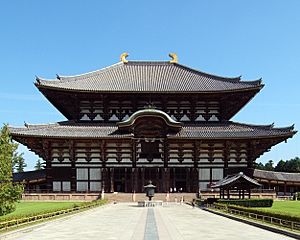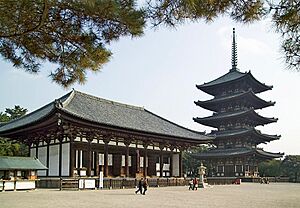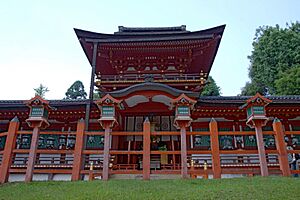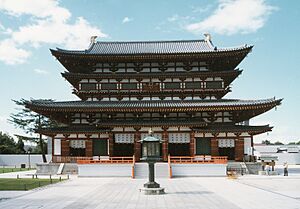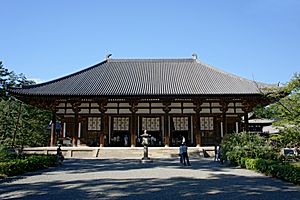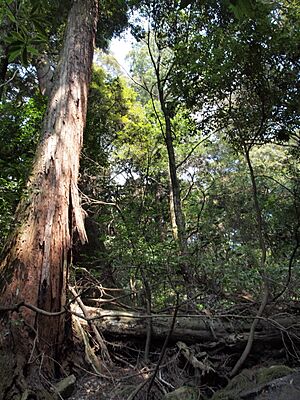Historic Monuments of Ancient Nara facts for kids
| UNESCO World Heritage Site | |
|---|---|
| Location | Nara Prefecture, Kansai region, Japan |
| Criteria | Cultural: (ii), (iii), (iv), (vi) |
| Inscription | 1998 (22nd Session) |
| Area | 617 ha (1,520 acres) |
| Buffer zone | 1,962.5 ha (4,849 acres) |
The Historic Monuments of Ancient Nara is a very special place in Nara Prefecture, Japan. It is recognized by UNESCO as a World Heritage Site. This means it's super important for everyone in the world to protect and learn about!
This site includes eight amazing places in Nara. Nara was once the capital city of Japan. Five of these places are Buddhist temples. One is a Shinto shrine. Another is a grand palace. The last one is a very old, untouched forest.
Contents
Nara's Ancient History
Nara was the capital city of Japan from the year 710 to 784. The old buildings and places in Nara show us what life was like in Japan's capital during the 8th century. It's like a time capsule!
Protecting Nara's Treasures
All the shrines and temples here are known as "Historic Sites of Japan." This means they are officially protected because of their history. The Nara Palace is even more special, called a "Special Historic Site." The Kasugayama forest is a "Natural Monument." This means it's a very important natural area.
Many buildings at these sites are super valuable. The Japanese Government has named 26 buildings as "National Treasures of Japan." There are also 53 buildings called "Important Cultural Properties." These names show how much these places mean to Japan's history and culture.
In 1998, UNESCO added parts of Nara to its World Heritage List. This helps make sure these amazing places are preserved for future generations.
The Eight Special Places
The World Heritage Site in Nara includes these eight incredible locations:
- Tōdai-ji (Eastern Great Temple): This is a famous Buddhist temple. It houses a giant bronze statue of Buddha.
- Kōfuku-ji (Kōfuku Temple): Another important Buddhist temple. It was once one of the most powerful temples in Japan.
- Kasuga Shrine (Kasuga-taisha): This is a beautiful Shinto shrine. It is famous for its many bronze and stone lanterns.
- Gangō-ji (Gangō Temple): This Buddhist temple has a very long history. It is one of Japan's oldest temples.
- Yakushi-ji (Yakushi Temple): This Buddhist temple is known for its beautiful architecture. It has two tall pagodas.
- Tōshōdai-ji (Tōshōdai Temple): This Buddhist temple was founded by a Chinese monk. It has a very peaceful atmosphere.
- Heijō Palace (Heijō-kyū): This was the imperial palace during the Nara period. It was the home of the emperor and the center of government.
- Kasugayama Primeval Forest (Kasugayamagenshirin): This is an ancient forest. It has been protected for centuries because it is connected to the Kasuga Shrine.
Related pages
See also
 In Spanish: Monumentos históricos de la antigua Nara para niños
In Spanish: Monumentos históricos de la antigua Nara para niños


